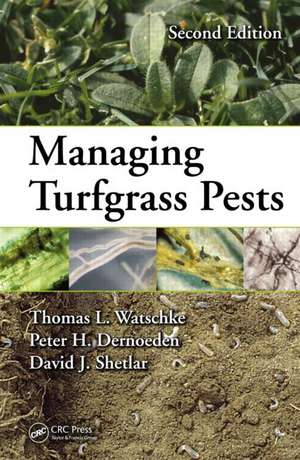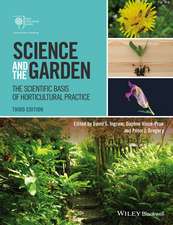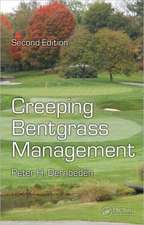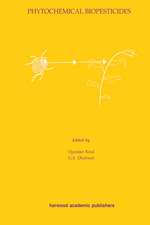Managing Turfgrass Pests
Autor Thomas L. Watschke, Peter H. Dernoeden, David J. Shetlaren Limba Engleză Hardback – 16 apr 2013
The book discusses the concept of integrated pest management, incorporating cultural, biological, and chemical control measures. In particular, the authors emphasize the philosophy of minimizing pests through well-defined and well-implemented cultural systems. Rather than simply relying on a pesticide solution for control, they explain how to fine-tune cultural practices to better address the question of why the pest is present in the first place. Once these cultural practices are in place, any pesticide that is still required will be much more effective at controlling the pest.
New in This Edition
- Revised and updated descriptions of economically important turfgrass pests
- Revised and updated cultural approaches to turfgrass pest management
- Revised and updated biological methods of turfgrass pest management
- Revised and updated chemical control of turfgrass pests
- More than 200 new color illustrations
| Toate formatele și edițiile | Preț | Express |
|---|---|---|
| Paperback (1) | 582.21 lei 6-8 săpt. | |
| CRC Press – 22 noi 2017 | 582.21 lei 6-8 săpt. | |
| Hardback (1) | 1191.54 lei 6-8 săpt. | |
| CRC Press – 16 apr 2013 | 1191.54 lei 6-8 săpt. |
Preț: 1191.54 lei
Preț vechi: 1673.76 lei
-29% Nou
Puncte Express: 1787
Preț estimativ în valută:
228.03€ • 237.19$ • 188.25£
228.03€ • 237.19$ • 188.25£
Carte tipărită la comandă
Livrare economică 14-28 aprilie
Preluare comenzi: 021 569.72.76
Specificații
ISBN-13: 9781466555075
ISBN-10: 1466555076
Pagini: 520
Ilustrații: 279 color images
Dimensiuni: 156 x 234 x 25 mm
Greutate: 1 kg
Ediția:Revizuită
Editura: CRC Press
Colecția CRC Press
ISBN-10: 1466555076
Pagini: 520
Ilustrații: 279 color images
Dimensiuni: 156 x 234 x 25 mm
Greutate: 1 kg
Ediția:Revizuită
Editura: CRC Press
Colecția CRC Press
Public țintă
ProfessionalCuprins
Weeds and Their Management: Introduction. Managing Turfgrass Weeds. Managing Summer Annual Grasses. Managing Winter Annual Grasses. Managing Perennial Grasses and Sedges. Managing Summer Annual Broadleaf Weeds. Managing Winter Annual Broadleaf Weeds. Managing Biennials. Managing Perennial Broadleaf Weeds. Weed Management: Integrated Pest Management. Chemical Control Recommendations. Further Reading. Turfgrass Diseases and Their Management: Introduction. Monitoring Disease and Establishing Thresholds. Environmental Conditions and Use of Cultural Practices to Manage Diseases. Biological Control of Turfgrass Diseases. Winter and Early Spring Diseases. Diseases Initiated in Autumn or Spring That May Persist Into Summer. Diseases Initiated During Summer That May Persist Into Autumn. Seedling Diseases or Damping-Off. Bacterial Diseases. Plant Parasitic Nematodes. Virus Diseases. Blue-Green Algae, Moss, and Black-Layer. Collecting and Sending Diseased Samples to a Lab. Fungicides Used to Control Turfgrass Diseases. Acknowledgments. Bibliography. Turfgrass Insect and Mite Management: Goal of Insect and Mite Management. Pest Management Process. Pest Identification. Insects and Mites Associated with Turf: An Introduction. Pest Life Cycles. Zones of Activity (Turf, a Unique Habitat). Monitoring. Selecting Appropriate Controls. Leaf- and Stem-Infesting Insect and Mite Pests. Stem- and Thatch-Infesting Insect and Mite Pests. Soil-Inhabiting (e.g., Thatch- and Root-Infesting) Insects. Nuisance Invertebrate, Insect, and Mite Pests. Nuisance Vertebrate Pests. Further Reading. Index.
Notă biografică
Dr. Thomas L. Watschke is presently professor emeritus of turfgrass science at the Pennsylvania State University, where he was on the faculty for 35 years. Dr. Watschke has been honored nationally by the Golf Course Superintendents Association of America and the American Sod Producers Association, Division C-5 (ASA, CSSA) Grau Award, and has been accorded fellow status by both the Crop Science Society of America and the American Society of Agronomy. He is recognized throughout the world for his teaching and research accomplishments in weed science, plant growth regulation, and water quality. He has made presentations in France, Australia, Spain, England, Scotland, and Canada and is active in the International Turfgrass Society.
Dr. Peter H. Dernoeden is a professor of turfgrass science in the Department of Plant Science and Landscape Architecture at the University of Maryland. Dr. Dernoeden has published more than 100 scientific journal articles and several books, including Creeping Bentgrass Management, Second Edition. He is a Fellow of the American Society of Agronomy and the Crop Science Society of America (CSSA). He received the Fred V. Grau Turfgrass Science Award from the Turfgrass Science Division of CSSA. He was also the recipient of The Dean Gordon Cairns Award for Distinguished Creative Work in Agriculture from the College of Agriculture and Natural Resources at the University of Maryland. In 2012, he received the Colonel John Morley Distinguished Service Award from the Golf Course Superintendents Association of America.
Dr. David J. Shetlar is a professor of urban landscape entomology at The Ohio State University. Dr. Shetlar has authored and coauthored numerous trade magazine articles, research journal articles, books and book chapters, and extension factsheets and bulletins. Dr. Shetlar, who goes by the professional nickname of the "BugDoc," produces the popular P.E.S.T. Newsletter in association with the Ohio Nursery and Landscape Association. He was one of the recipients of an Annual Leadership Award presented by Lawn and Landscape and Bayer in 2005. He also received the Educator & Public Service Award from the Ohio Nursery and Landscape Association in 2010.
Dr. Peter H. Dernoeden is a professor of turfgrass science in the Department of Plant Science and Landscape Architecture at the University of Maryland. Dr. Dernoeden has published more than 100 scientific journal articles and several books, including Creeping Bentgrass Management, Second Edition. He is a Fellow of the American Society of Agronomy and the Crop Science Society of America (CSSA). He received the Fred V. Grau Turfgrass Science Award from the Turfgrass Science Division of CSSA. He was also the recipient of The Dean Gordon Cairns Award for Distinguished Creative Work in Agriculture from the College of Agriculture and Natural Resources at the University of Maryland. In 2012, he received the Colonel John Morley Distinguished Service Award from the Golf Course Superintendents Association of America.
Dr. David J. Shetlar is a professor of urban landscape entomology at The Ohio State University. Dr. Shetlar has authored and coauthored numerous trade magazine articles, research journal articles, books and book chapters, and extension factsheets and bulletins. Dr. Shetlar, who goes by the professional nickname of the "BugDoc," produces the popular P.E.S.T. Newsletter in association with the Ohio Nursery and Landscape Association. He was one of the recipients of an Annual Leadership Award presented by Lawn and Landscape and Bayer in 2005. He also received the Educator & Public Service Award from the Ohio Nursery and Landscape Association in 2010.
Recenzii
"Drs. Watschke, Dernoeden, and Shetlar are considered the ‘three tenors’ of turfgrass pest management; this second edition combines their unmatched expertise in the biology and management of turfgrass weeds, diseases, and insects. The up-to-date information presented in this second edition translates fundamental turfgrass science research into applicable turfgrass management solutions. This second edition of Managing Turfgrass Pests should be in a reachable location on the shelf of every turfgrass and green industry practitioner."
—Michael Fidanza, Ph.D., The Pennsylvania State University
"This text provides current information on the management of weeds, diseases, and insects. In each section, the authors introduce key concepts (e.g., understanding the conditions favorable to the pest and monitoring techniques). A brief description of each pest is included, including the life cycle. One of the strengths of the book is that the authors then provide several concise suggestions for managing the pest, encouraging the incorporation of appropriate cultural strategies that may enable the turf to withstand some pest pressure. ... [This book] should be considered a valuable addition to any turf manager's reference library."
—Patricia Vittum, Ph.D., University of Massachusetts
Praise for the Previous Edition
"As an educator, I found the book to be useful because it pulls together the three major areas of turfgrass pest management into a single source. There are many individual texts available on turfgrass weeds, diseases, and insects, but their combined cost makes them impractical for a survey course that covers all three areas. The book also would make a useful addition to the personal libraries of turfgrass professionals and should find a ready audience in the golf course and lawn care industries."
—HortScience, Vol. 30, No. 7, December 1995
"This is one of the few books I have come across that incorporates in the one volume the three sections of turfgrass pests—weeds, insects and diseases."
—D. Howard, New Zealand Turf Culture Institute
—Michael Fidanza, Ph.D., The Pennsylvania State University
"This text provides current information on the management of weeds, diseases, and insects. In each section, the authors introduce key concepts (e.g., understanding the conditions favorable to the pest and monitoring techniques). A brief description of each pest is included, including the life cycle. One of the strengths of the book is that the authors then provide several concise suggestions for managing the pest, encouraging the incorporation of appropriate cultural strategies that may enable the turf to withstand some pest pressure. ... [This book] should be considered a valuable addition to any turf manager's reference library."
—Patricia Vittum, Ph.D., University of Massachusetts
Praise for the Previous Edition
"As an educator, I found the book to be useful because it pulls together the three major areas of turfgrass pest management into a single source. There are many individual texts available on turfgrass weeds, diseases, and insects, but their combined cost makes them impractical for a survey course that covers all three areas. The book also would make a useful addition to the personal libraries of turfgrass professionals and should find a ready audience in the golf course and lawn care industries."
—HortScience, Vol. 30, No. 7, December 1995
"This is one of the few books I have come across that incorporates in the one volume the three sections of turfgrass pests—weeds, insects and diseases."
—D. Howard, New Zealand Turf Culture Institute
Descriere
Written by top turfgrass professionals, this second edition of a bestseller presents hundreds of solutions and best practices to help you manage turfgrass weeds, diseases, and insects more effectively. It explains how to integrate cultural, biological, and chemical management tactics to ensure quality and functional turf on lawns, athletic fields, and golf courses. Rather than simply relying on a pesticide solution, the authors discuss how to fine-tune cultural practices to optimize the competitiveness of your turfgrass against the pests that inevitably become part of any ecosystem.







